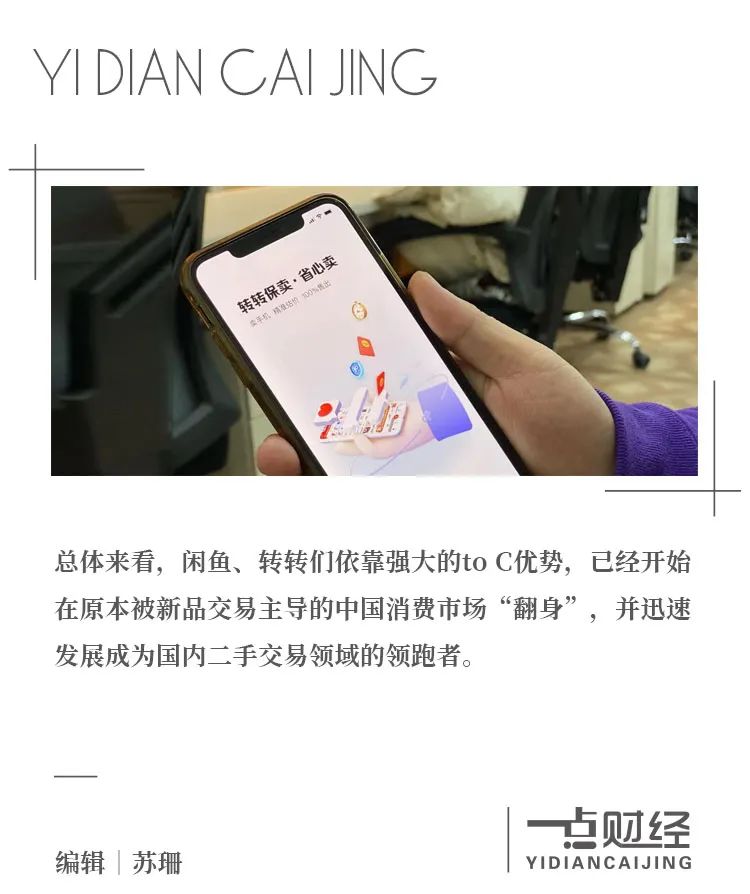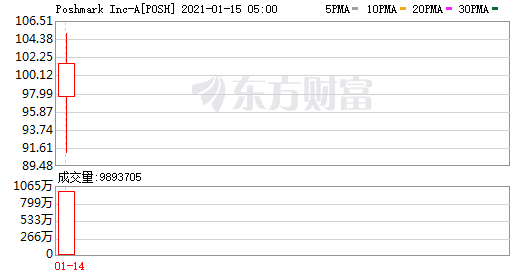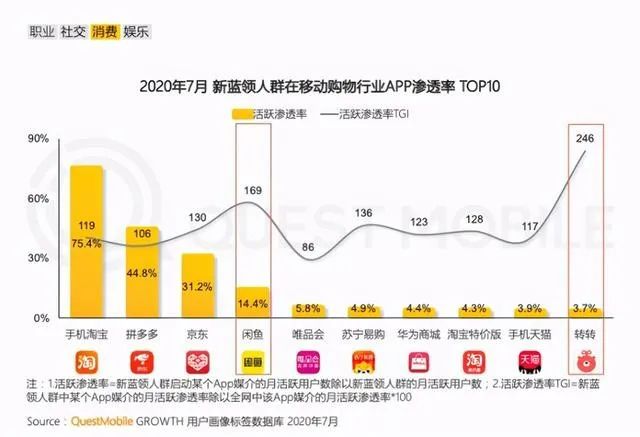
On January 15, 2021, Poshmark (stock code: POSH), known as the US version of "Xianyu", was listed on the Nasdaq.
This e-commerce platform, which deals mainly in second-hand clothing, shoes and accessories, issued a total of 6.6 million shares and raised a total of US$278 million. On the first day of listing, Poshmark's stock price soared by 141.67% from its issue price of $42, and its market value once exceeded $7.4 billion.

Before Poshmark, Mercari, a second-hand e-commerce company from Japan, was listed on the Tokyo Stock Exchange in 2018. At that time, its stock price soared 76% on the first day of listing.
In emerging markets, second-hand consumption has formed a new wave sweeping the world.
On the one hand, under the multiple influence of factors such as the global economic downturn and the epidemic, consumers in various countries have begun to pay attention to the value of idle goods, and consumer demand has become more diversified; on the other hand, the online rate of second-hand transactions has increased significantly, and second-hand e-commerce The platform began to rise.
There are many players, different business focuses, and different models. But overall, whether it is Poshmark, the realreal, carvana in the United States, or Mercari in Japan, they are all platforms based on to C.
In China, the same is true.
In the past two to three years, China’s second-hand consumer market has gradually expanded, reaching a trillion scale by 2020; at the same time, domestic comprehensive second-hand e-commerce represented by Xianyu and Zhuanzhuan, as well as Hong Bulin, Vertical platforms such as looking for a cool machine, loving recycling, and catching more fish have attracted capital and market attention, and ushered in a period of rapid development.
The business and business models of these domestic platforms are not the same, but the development of second-hand e-commerce in Europe and the United States has "different routes to the same goal":
Relying on their strong to C advantages, Xianyu and Zhuanzhuan began to "turn over" in the Chinese consumer market dominated by new product transactions, and quickly became the domestic front-runner in the field of second-hand transactions; vertical subdivisions, red brin and look for cool opportunities, etc. The original to C-based platform also achieved impressive results; even the original to B’s Aihuihui and Huihuibao, etc., have begun to gradually shift to to C or rely on giants with C-side advantages to gain more room for development .
Therefore, when everyone is talking about the industrial Internet and discussing the stability of to B, in the field of second-hand consumption, to C is still the direction and track with the most development potential.

The stock price of the US version of "Xianyu" has skyrocketed. Selling used clothes to buy a house in California?
Poshmark, which has just been listed on the Nasdaq, mainly sells second-hand clothing and accessories, including second-hand T-shirts, high-end boutique women's clothing and its own brands. Consumers can bid on the products, also known as the American version of "free fish."
On January 15, 2021, on the first day of Poshmark's (stock code: POSH) listing on the Nasdaq in the United States, its stock price soared by 141.67% from its issue price of $42, and its market value once exceeded $7.4 billion.

In the past two quarters, Poshmark's profit exceeded 30 million US dollars; and its unique social functions also make it different from other e-commerce companies such as Amazon and eBay. There have been media reports that a full-time mother relies on Poshmark to sell clothing and can buy a house in California with a few years of profit.
Poshmark is also another US second-hand e-commerce platform listed on the US stock market after TheRealReal.
It is understood that The RealReal was founded in 2011 and is an online consignment platform for second-hand luxury goods in the United States. Its business focuses on the consignment of second-hand high-end handbags, clothing, jewelry and watches. It was listed on the Nasdaq in August 2019.
Data from ThredUp, an American second-hand e-commerce platform, shows that in 2020, especially during the Christmas holidays, more American consumers will start buying second-hand luxury clothing, accessories, jewelry and other commodities. However, for Americans who are currently suffering from the epidemic and the high unemployment rate, second-hand transactions are no longer limited to luxury goods. Buying more types of idle items has become an important choice for income and meet life needs.
The annual report released by ThredUP also mentioned that compared with the current US$28 billion transaction scale, the US second-hand market transaction scale is expected to grow to US$64 billion in the next 5 years; by 2029, it will include online resale and traditional thrift stores. Including the entire US second-hand market, the total value is expected to reach 80 billion US dollars.

Second-hand consumption has formed a new wave and has become popular all over the world
Behind the popularity of Poshmark in the US stock market, it actually reflects that second-hand consumption has formed a new wave sweeping the world.
The French "Le Figaro" recently published an article that in 2020 the sales of second-hand goods in the fields of French fashion, furniture, and decoration will usher in a substantial increase. Among them, the sales of the second-hand commodity trading platform "Serance" doubled compared to 2019; in addition, the most popular second-hand clothing platform Vinted has an increase of 17% in the products launched in 2020 compared with 2019; another fashion product transfer The sales website "Public Wardrobe" will release 17,000 items every day in 2020, and this number will be 10,000 in 2019.
Gask, the sales manager of the "Public Wardrobe" website, said that during the epidemic prevention and control period, people have more time and energy to organize cabinets and put items no longer needed on the second-hand trading platform. This is also because some people are facing life difficulties due to short-term unemployment. Of people provide an additional source of income.
In January 2020, the French government also passed the "Anti-Waste Act" aimed at eliminating waste and developing a circular economy. The bill's appeal to the public also boosted the development of the country's second-hand goods market.

In Asia, second-hand trading in Japan has developed very mature: offline, you can see middle-aged stores everywhere; online and second-hand e-commerce platforms also have outstanding performance. Especially during the epidemic, the desire to simplify life and sell idle items has become stronger, and second-hand goods with higher cost performance are also in line with the current consumption habits of Japanese people "holding their wallets".
Japanese second-hand trading company Buysell Technologies said that in October 2020, the number of on-site recycling services reached 20,990, an increase of 31% year-on-year. Most sellers sold kimonos, designer bags and jewelry; the most popular online second-hand trading e-commerce Mercari also reported that , The sales from July to September 2020 increased by 52% compared with the same period last year.
It is worth noting that Mercari was listed on the Tokyo Stock Exchange in 2018, when its stock price soared 76% on the first day of listing.
Japanese media reported that under the booming supply and demand, the volume of the Japanese second-hand goods market soared 70% during the epidemic, with 36 million potential users, close to one-third of Japan's total population, and the market size exceeded 3 trillion yen.

China's second-hand transaction scale reaches trillions, and the market has accelerated reshuffle
It must be said that the epidemic has had a greater impact on the economy, consumption and residents' lives. It has not only accelerated the popularity of the global second-hand economy, but also promoted the rapid development of China's second-hand market to a certain extent.
According to data from the MobData Research Institute, the annual transaction volume of second-hand idle in China was 742 billion in 2018, 964.6 billion in 2019, and 1,254 billion in 2020, reaching a trillion scale.
Behind the scale is the gradual explosion of demand.
In 2015, Pinduoduo was established, and social play became popular; in the same year, the proportion of mobile terminals in Tmall Double 11’s GMV reached 68%. The Chinese Internet consumer market has entered the era of mobile e-commerce from PC e-commerce.
Also around this year, non-standard products represented by second-hand transactions entered the public eye, second-hand cars, second-hand 3C, second-hand books, second-hand luxury goods...
Compared with new products, the transaction of second-hand products has remained niche for many years. However, in the context of the explosion of diversified consumer demand, platforms related to second-hand trading such as idle fish, melon seeds, Zhuanzhuan, find a good opportunity, love recycling, catch more fish, and red brin, have emerged in the past few years.
Entering 2020, this trend will be more obvious in the consumer market. On the one hand, the epidemic at the beginning of the year accelerated the online trend; on the other hand, the slowdown in economic and income growth has caused more and more people to focus on rational consumption, and the penetration rate of idle transactions is gradually increasing.

36 krypton’s previously released "User Observation Report under the Second-hand Economy" mentioned that Chinese people’s acceptance of second-hand transactions has increased significantly in the past two years, and over 70% of the interviewed users conduct second-hand transactions 1-2 times a week. Some respondents said they would trade second-hand items.
In fact, similar to Europe, America, Japan and South Korea, China also has a traditional second-hand market, but second-hand transactions are really ushering in rapid development. On the one hand, the economic environment has made more people realize that the value of idle items should not be wasted; on the other hand, It is directly related to the substantial increase in the online rate of second-hand transactions.
Statistics show that in the past ten years, the total annual registration volume of China and second-hand idle-related companies has been continuously increasing. As of August 2020, according to industrial and commercial registration, my country has newly added 110,000 second-hand idle-related enterprises, a year-on-year increase of 52% compared to 2019.
It is worth noting that in March 2020, 23 departments including the National Development and Reform Commission jointly issued the "Implementation Opinions on Promoting Expansion and Quality of Consumption and Accelerating the Formation of a Strong Domestic Market", encouraging companies to trade in old ones and rationally guide consumption expectations. This also means that when the incremental market for consumer goods gradually turns to the stock market, China's second-hand idle economy has also begun to usher in a golden period of development.
In this process, with the rapid development of the mobile Internet, capital and giants have entered the game one after another, and consumers' awareness of second-hand use has also been deepened in rounds of advertising wars and real trading experiences.
In this process, China’s online second-hand trading market is also accelerating its reshuffle: Looking at the entire market, the two comprehensive second-hand e-commerce platforms, Xianyu and Zhuanzhuan, account for more than 90% of the market share; vertical segmentation, Finding a beautiful machine, Ai Huihui, Huihuibao, Red Bolling, catching more fish, and getting things have all achieved rapid growth through deep cultivation.

"Different routes have the same goal", Xianyu, turn to to C "turn over"
The US media reported that the US version of "Xianyu" Poshmark can be hailed in the capital market, and two core data have attracted much attention:
- As of September 2020, a total of 200 million second-hand and new products have been sold on the Poshmark platform, involving 9,431 brands;
- As of September 2020, the Poshmark platform has 31.7 million active users, 6.2 million active buyers and 4.5 million active sellers.
These two data actually represent the two major elements in second-hand transactions: supply and demand.
From the perspective of the transaction itself, in fact, the largest supply comes from the C side, and the largest demand is also on the C side. Therefore, whether it is Poshmark, the realreal, carvana in the United States, or Mercari in Japan, etc., they are all platforms based on to C.

In China, the same is true.
As mentioned above, the platforms developed in the Chinese second-hand trading market in the past two or three years, although the social and economic environments are different from those of foreign countries, and the platforms themselves have different business and business models. The development path of second-hand e-commerce in developed countries such as Europe, America and Japan is to a certain extent "different routes to the same goal."
The first is idle fish: it was launched in June 2014 and is still in the Ali system. The C2C model focuses on idle information matching. In terms of development strategy, Xianyu is similar to Poshmark, gathering traffic through social interaction. One of the most distinctive features is to visualize interactive communities as "fish ponds" and stimulate user transactions through social interactions.
According to official data released by Xianyu, there are currently about 1 million people posting idle personal items on Xianyu every day, the number of which exceeds 2 million. According to Xianyu's recent brand strategy upgrade, "new offline" is Xianyu's key business direction in the next two to three years. Xianyu has stated that in the next three years, Xianyu bases will be established in 20 cities across the country, and Xianyu Station will be deployed in more than 50 cities, and Xianyu Market will also be extended to 30 cities. Generally speaking, Xianyu is advancing the matter of converging traffic from online to offline, but the grand strategic direction of to C has not changed.
Let's look at the transformation: it went online at the end of 2015, and initially adopted a dual-track parallel model of C2C and C2B2C. Under the C2C mode, Zhuzhan provides second-hand transaction services for all categories; under the C2B2C mode, Zhuzhan cuts into the second-hand mobile phone category, and is the first to launch inspection and quality inspection services in the industry, and then gradually covers books, 3C digital, beauty and other categories .
In May 2020, Zhuanzhuan and Liangji strategically merged, among which Liangji is mainly based on the B2C model. Although for the second-hand mobile phone business, Zhuanzhuan has also incubated B2B buyers and C2B warranty services, but the group as a whole is a C2B2C-based model. The core of this is actually Zhuan Zhuan's role in providing intermediary performance services, that is, the construction of the quality inspection system mentioned above, as well as the quality assurance and after-sales service that were introduced later.
Compared with the information matching under the pure C2C model, the transfer is inserted between the C1 end (seller) and the C2 end (buyer) to implement a ring of performance services in order to promote the effective circulation of idle items by enhancing trust. From this point of view, the TherdUP in the United States is similar to Zhuanzhuan: ThredUP did not adopt the pure C2C model used by second-hand platforms, but also chose the C2B2C model. The specific operation process is as follows: the user packs the second-hand clothes into a unified platform bag, and ThredUP sends someone to take it away. The clothes need to pass ThredUP inspection before they can be sold.
In fact, in the second-hand vertical segmentation field, the platforms that have been able to achieve better development in recent years are also platforms dominated by to C business, such as looking for a good machine, red brin, more fish, and so on.
At the same time, some platforms in the market that were originally based on to B services are also beginning to transform or enrich their own business lines. For example, in the vertical field of second-hand 3C, vertical platforms such as Aihuihui and Huihuibao have also begun to explore to C business. The core model of Aihuihui and Huihuibao is C2B, and its main business is the recycling of second-hand mobile phones. For example, iRecycling relies on the traffic imported from JD.com and offline stores to obtain the mobile phone recycling orders, and then send bulk cargo to the downstream B-side.
From the perspective of the vertical category of second-hand mobile phones, the single C2B mobile phone recycling business has faced sluggish growth in the past few years. From the daily receipts of these vertical recycling platforms, it can be seen that in recent years, it has been maintained at around 7,000, with no significant growth. For the second-hand consumer market that has ushered in the new wave, a single to B business is actually not enough to support long-term development, so these platforms are also beginning to explore the transition to to C.
Because only idle items eventually flow to the C2 end consumers in need, the value will not be wasted; and for the platform and C1 end users, can also generate benefits.
This is also the core value of second-hand consumption.
Therefore, in 2018, Huihuibao announced that it had received a strategic investment from Alibaba. At the same time, it also reached in-depth cooperation with Xianyu in credit recovery, Xianyu Youpin, Tmall Taobao trade-in and other areas; and Huihuibao attached to Xianyu to C. It is different in providing third-party services. In 2019, Aihuihui and JD.com merged with the auction strategy of "slimming" to sell, and began to get involved in the B2C field. In September 2020, at the press conference for the brand strategy upgrade of Aihuishou, it was also announced that it would rely on its own control of goods to accelerate the development of B2C business and achieve another leap in business model.

The benefits of seizing the "C" position to the second-hand e-commerce platform are also obvious.
Alibaba’s financial report data shows that "Xianyu"’s GMV has exceeded 200 billion yuan, an increase of 100% year-on-year, and the number of online sellers exceeds 30 million per day. Aurora Big Data and other third-party organizations report reports that Zhuanzhuan After the merger of Find Liangji, on the basis of maintaining the development characteristics of the whole category, in the second-hand 3C market that it focuses on, it has also ranked first in the second-hand mobile phone online user transaction and B2C field. It also occupies a dominant position in the second-hand recycling market.

Conclusion
On the whole, Xianyu and Zhuanzhuan, relying on their strong to C advantages, have begun to "turn over" in the Chinese consumer market originally dominated by new product transactions, and have rapidly developed into the domestic front-runner in the field of second-hand transactions.
In the field of vertical segmentation, platforms that originally focused on to C services, such as Red Bolin and Find Liangji, have also achieved outstanding results in the areas they focus on; even the original to B’s Ai Huihui and Huihuibao have begun to gradually shift to C or rely on giants with C-end advantages, seeking more room for development.
Therefore, when everyone is saying that the consumer Internet has shifted to the industrial Internet, to C is still the most important part of the "blue ocean" in the online second-hand consumer field, which has a slower pace of development than the new product market and has not yet ushered in a complete explosion. Directions and tracks with development potential.